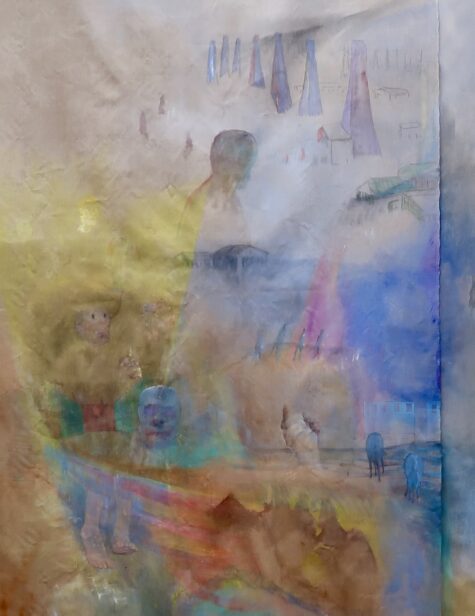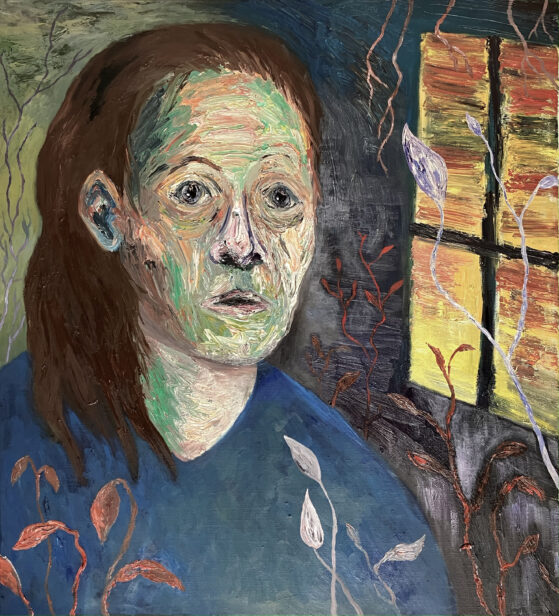Verna Joki
ice cream, a hundred years, and an aeroplane
Verna Joki paints with ink from perception. Her perception is direct: it requires her immediate presence with the painted subject, thus allowing the images to emerge directly. Joki’s works convey lightness and speed, both in the handling of color and in the use of the translucent white silk as a support for the painting.
The impression of the precious silk is akin to that of thin tissue paper, yet the fabric’s memory is shorter and more fleeting than paper’s. Unlike paper, the silk fabric can be straightened and smoothed, and wrinkles can be made to disappear. The shimmering silk also lacks the dry feel of paper, instead it allows color to seep through. The choice of lightly primed silk as the ground for the paintings also affects the form of the works, as mere stretcher bars are enough to hold the piece together, eliminating the need for frames or passepartout. This sense of directness extends to the structure of Joki’s works.
However, both fabric and tissue paper share a sense of transience. If the artist makes a mistake while painting, it is irreversible. Once a stroke is made, it is difficult or even impossible to correct it. The delicately translucent, softly draping silk proves to be unforgiving, as every single mark remains permanent. Attempts to erase an unwanted trace would only leave more marks, more corrections, more pigment on the ground.
Each stroke is inevitable, to the extent that it is almost a matter of destiny, as it determines the entire content of the work. While painting, the artist’s process is almost like stepping into the unknown, with the color emerging from an unformed space of nothingness and the stroke advancing toward the white background. For this reason, the brushstrokes, reminiscent of calligraphy, cannot be fully envisioned before the stroke is made. Drawing and painting thus become a blind act moving toward the unseen.
The lines in Joki’s ink paintings are dense yet light. They carry a strong sense of effortless motion, giving the impression that the works have formed on their own and the lines have settled into place without strain. This impression is reinforced by the fact that Joki leaves space in her works—unpainted silk beyond the image field. Not everything has to be filled in it, and the white areas become as meaningful as the fully painted surfaces. Out of the two main colors – black and light gray – the gray appears like shadows cast by the black, creating a sense of depth and overlapping layers. In works like Palta in Kyrönlahti, Spring warble, Afternoon in Kyrönlahti, essays, and Studio view without Hammershøi, landscapes merge with objects in a still life arrangement. Meanwhile, Grandpa’s still Life, Souvenir from Lempäälä, and Clivia seem to first reveal the objects before opening them toward a landscape. The circle closes with Venice: a holiday image from a waterfront promenade, where converging and diverging lines complement each other like diagonals placed in the moment. The density of the lines fades, only to intensify again in the next moment. Joki’s rhythm of line is also the rhythm of the gaze, its movement across the silky surface.
Martta Heikkilä, PhD, Aesthetics
The artist thanks Kone Foundation and Finnish Art Society for the support of her work.
Verna Joki’s artistic practice consists of drawing from perception with ink. She earned her Master of Fine Arts from the Academy of Fine Arts at the University of the Arts Helsinki in 2021 and completed her studies in painting at the Free Art School in 2017. Joki has held several solo exhibitions in Finland, most recently in 2023 at the Taidekeskus Mältinranta in Tampere, the Poriginal Gallery in Pori, and the Oksasenkatu 11 Gallery in Helsinki.
In 2023, Joki was awarded the Finnish Art Society’s Young artist grant. She is currently working with the support of a three-year grant from the Kone Foundation. Joki’s works are included in the Finnish State Art Collection.

Paavo Paunu
MINÄ, ONNI JA ORVOKKI
Minä, onni ja orvokki is a painting with several nested levels. There are animals and people, an armchair, towers and houses. Some appear as shadows, others float as colors.
The painting is also a place for looking, and at the same time it is the interface between two different spaces. In the space of Forum Box, the painting can be seen both large and small. There, inside the painting, a person searches for their essence, strives towards something, perhaps balance, perhaps happiness.
Paavo Paunu‘s (b. 1965) paintings and sculptures depict the human being – dreams and disappointments as well as the relationship with nature. Paunu has created large-scale works that have also acquired a spatial dimension. The paintings have become stages that expand to front and behind. Paunu is a painter of space, and he positions his paintings in such a way that they become installations. Wood as a material is one of the concrete platforms for painting: it can be carved and painted – it is possible to implant new elements on the surface of the wood. The sculptures show the careful, time-consuming work: only the working process brings out the wood material and gives it form, showing the material as it is.
Paunu is not limited by the usual tools of sculpture or painting, nor by obvious models, genres or references to theoretical sources. The voice of the works echoes from further away, from a world of its own, which is a human reality. It is characterised by psychological surrealism and expressive symbolism. It is as if Paunu is searching for the timeless core of the human being, the causes and consequences of actions, emotions ranging from goodness, confidence and triumphalism to shame and disbelief. Paunu’s images reflect the uniqueness of experience and the human relationship to the unknown dimensions of the world: nature, the depths of the mind, the imagination of the artist and the viewer.
Biography: Martta Heikkilä, PhD, Aesthetics

Hiljaista kasvua (2023), oil on canvas, 110 × 100 cm. Photo: Ville Välikangas.
Ville Välikangas
Eternity Around Me
I read news about space. However, I don’t understand much about their scientific language in general. What I understand is that space is everywhere around us: left, right, front, behind, above our heads and under our feet, and space goes on endlessly in all possible directions. The Earth hangs and races in the dark infinity, insignificant and small. For us, however, our planet is the home of our lives, the place of our memories. This is where we are born into our childhood, our old age, the changing seasons, surrounded by eternity.
Existence as a subject interests me, and depicting humanity has always been important to me. Experiences of fragility and fear are repeated in my images. In addition to people, landscapes are a recurring motif. I don’t plan my paintings, the work is created in the moments of painting, by making mistakes and succeeding on the painting surface. My style of painting is expressive and I often use plenty of paint. In addition to expressionism, my images can be influenced by surrealism and sometimes naivism, for example. Events in the world, such as wars, also sometimes affect my works. Making an image is a way for me to live and exist.
The exhibition has been supported by the Kone Foundation and the Finnish Cultural Foundation.
Ville Välikangas (b. 1983) is a painter from Kirkkonummi, who currently lives in Kerava and works in Tuusula. Välikangas graduated with a Bachelor of Fine Arts degree from the Lahti Art Institute in 2015 and studied fine arts at the Pekka Halonen Academy from 2005 to 2008. Välikangas works mainly with oil paints, but he also paints with watercolors and gouaches. This is his tenth solo exhibition.
Mediabox
